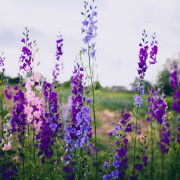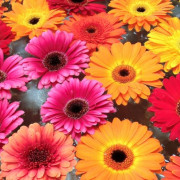Godetia flower - growing from seed at home
Content:
Godetia is an annual flower of the Cyprian family. It is classified as a Clarkia variety for its slight resemblance to it and its bright color. Today this plant (native to North and South America) has spread throughout the world, becoming a highlight decorating flower beds, balconies and street pallets.
Large buds of godetia delight the eyes for a long period of time. It is an annual and cold-resistant plant with straight, branched and spreading branches, decorated with large leaves. The buds are like bells with a diameter of 4 to 8 cm.
Growing conditions in the open field
Many gardeners like Godetia because of its unpretentiousness to care, it is easy to grow it in any conditions. Its ability to adapt quickly allows it to choose loyal growing conditions. Therefore, she is a frequent visitor to the backyard flower beds.
When choosing a place for planting, it is worth giving preference to areas without ventilation and with a little partial shade. It is not very demanding on soils, but it grows best on loams. The simplicity of godetia to heat allows it to quickly recover in the spring after sudden changes in temperature. This ability also allows gardeners to enjoy the flowering of the plant until the first frost in the fall.
It is worth feeding flower bushes twice a season with ready-made fertilizers for flower crops. It will be better if the dose of top dressing is slightly lower than the description on the package, since godetia reacts strongly to food. Excessive nutrient intake can adversely affect the plant.
Watering should be organized more strictly, since moisture and its stagnation can cause wilting of the aerial part, as well as rotting of the root system. To prevent these troubles, it is necessary to organize a simple drainage system during planting (pour pebbles or expanded clay on the bottom of the holes or pots). If, nevertheless, the plant has suffered from waterlogging, the affected flower bush should be completely removed from the flower bed in order to prevent the spread of putrefactive root disease.
Faded buds must be removed immediately after wilting. These actions allow you to preserve the decorativeness of the plant, and also stimulate it to lay new shoots and abundant formation of new inflorescences.
Ways to propagate at home
The main way to multiply on a plot or at home is godetia growing from seeds. You can sow seed on seedlings or directly into the ground.The seeds of this flower culture are quite hardy, so germination can last for 3-4 years.
How to collect and prepare seeds
There are no special measures for preparing seeds for sowing. The only point is processing with potassium permanganate. Before sowing, the seed is placed in a weak solution for 30-40 minutes. Some gardeners, after such treatment, mix the seeds with sand for better sowing, since they are very small and wet.
Selection and preparation of soil for sowing
Special preparations for the substrate are not required. If it is purchased at a store, you can sow seeds in it and periodically check for germination. If you decide to prepare the mixture yourself, you only need to maintain the proportions in the preparation:
- Peat - 1 part;
- Garden land - 1 part;
- Sand - 0.5 parts.
Germination conditions
Growing godetia from seeds at home does not require creating an optimal germination option. All its species germinate well, even when sowing seeds before winter, the main thing is that the temperature does not fall below 25 degrees below zero, with the snow melting, the first shoots will appear. In Russian gardens, azalea godetia is most often found, its cultivation is due to the fact that its buds are very similar to lush azalea flowers.
A step-by-step guide to growing from seed
To get flawless godetia shoots by sowing seeds for seedlings or immediately on a flower bed, several agrotechnical rules should be taken into account.
When sowing seed in open ground, you must first select a place protected from drafts and direct sunlight. Due to its cold resistance, seeds can be sown in an open bed immediately after the snow melts. Sowing can be carried out into the ground until the beginning of May, performing the following work in stages:
- the soil of the site is dug up in advance before sowing with the introduction of humus or peat;
- furrows are organized with a depth of 2-3 cm, at a distance of 10 to 15 cm from each other;
- spill each of the grooves with warm water before planting;
- seeds are sown in 1-2 pieces at a distance of 5-6 cm from each other;
- furrows are sprinkled with soil and "slammed";
- crops are periodically checked, weeded and sprayed.
With the seedling method of sowing godetia, seeds are sown in boxes with the calculation of transplanting seedlings into the ground already in the 15th of April. The seedling process starts already in late February - early March.
For seedlings:
- The container for sowing is being prepared: it is washed, disinfected.
- Drainage is poured at the bottom of the box (pebbles, pebbles or expanded clay).
- The soil is poured into the container. For flower seedlings, it is best to use a special ready-made mixture.
- If the container for seedlings is divided into cells, 1-2 seeds are sown in each of them, if not, 1-2 seeds are sown every 1-1.5 cm.
- Sowing is lightly sprinkled with soil mixture and sprayed from a spray bottle.
- The container is covered with foil or glass.
Seedlings will appear in 10-14 days. When 3 leaves appear on each feces, the seedlings need to be cut out. Seedlings of godetia are difficult to transplant, so it is better to choose pots made of peat, use ready-made flower substrates for seedlings. If this was not found, or sown in a mixture of our own preparation, carry out the diving procedure carefully, then planting in the soil slowly, without damaging the root system.
- It is important to establish moderate watering without moisture stagnation after transplanting.
- Seedlings love a lot of light, so they need to be exposed on a windowsill, but the sun should not hit it too much.
- Gradually, the seedlings need to be taken out to the balcony, young plants need acclimatization, so they need to be hardened daily, starting at two hours a day.
- Before planting in a permanent place, it is good to dig up the ground, prepare the holes at a distance of at least 15 cm from each other and transplant the plant along with a lump of earth, protecting the root. The space between the bushes can be covered with peat, grass cuttings or sawdust.
Humidity
It is very important not to allow stagnation of water on the site or in pots (depending on how it was decided to use the plant in landscaping). Waterlogging of the soil can lead to root rot and the death of the entire planting.
Temperature
Seeds germinate with the onset of above-zero temperature, so any positive temperature is optimal for godetia.
Lighting
A lot of light is required for the emergence of friendly seedlings, but it should not be intrusive. The sun's rays harm an adult plant, and even more so the seedlings, therefore, it is required to shade the boxes with crops, planting seedlings in a permanent place is also required in partial shade.
These are the simple rules for how you can grow godetia at home or outdoors without difficulty. The main thing is to plant it in a shaded place so that it does not get burns, and also to tie up the shoots so that each flower bud does not sink strongly to the ground.
Video





















